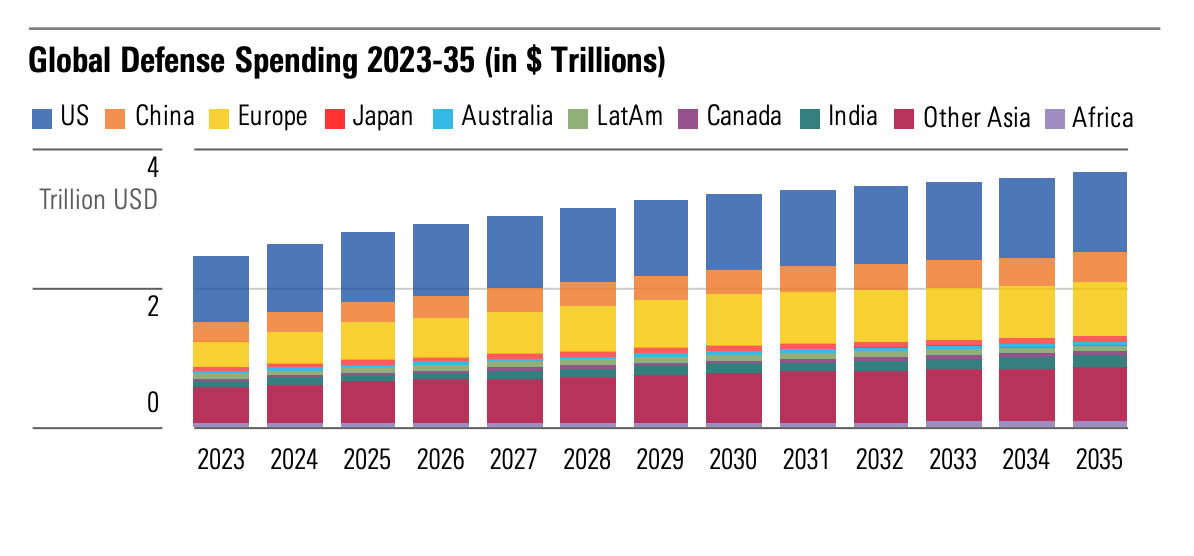4 min read
Navigating Investment Trends in the Global Defense Sector Landscape

Key Takeaways
Global defense spending is escalating, with a new defense supercycle anticipated to stimulate revenue and profitability in the US and Europe.
The top 15 global defense contractors have a significant influence on the market, with US firms holding the majority share.
US defense spending surpasses Europe's, leading to a more consolidated defense industry in the US.
European defense budgets are projected to rise, but previous underinvestment in defense is evident.
As the geopolitical landscape evolves and tensions escalate, a surge in global defense spending becomes evident. This upswing ushers in the advent of a new defense supercycle set to support revenue and profitability, particularly in the US and Europe. It's clear that we're entering a phase where defense investments are increasingly crucial, potentially offering a profitable frontier for advisors and asset managers to review with their investor clients and industry stakeholders.
We’re going to dive into the key drivers of this supercycle, as well as a look into the future of defense spending, focusing on how technological advancements carry an increased potential for profitability through economies of scale and aftermarket services.
The comprehensive “Global Defense Sector Landscape” report sheds light on the escalating defense spending, the significant role of top defense contractors, and the differences between US and European defense industries.
To read the full research report, download a copy.
Rising Global Defense Spending Trends and Investments
A closer examination of major market influencers reveals that the top 15 global defense contractors have a significant sway on the market, with US firms commanding the lion's share. US companies account for a staggering 59% of the top 15 defense contractors by revenue, illustrating the stronghold of US firms on the global defense market. This dominance underscores their significant position and influence within the industry.

Geopolitical Tensions and Security Threats Drive Defense Spending
US Defense Spending Outpaces Europe, but Maybe Not Forever
US defense spending outshines Europe's, paving the way for a more consolidated defense industry in the US. The data also spotlights the trend toward consolidating fragmented procurement in the country, forecasting that the market share of the top four contractors may experience a slight drop, paving the way for smaller OEMs to seize opportunities. This consolidation reflects a more streamlined and focused market landscape within the US defense industry.
However, European defense budgets are set to increase by an annual 5.8% from 2024 to 2034, surpassing the growth rates of the US, Russia, and China.

The US has steadily increased defense spending since 2017 and is projected to increase its budget in line with GDP, reaching 3.3% by 2035.
This increase in European defense spending is poised to boost the revenues and profitability of US and European companies, enabling scale economies through augmented production, and higher-margin aftermarket services like maintenance and upgrades.
Despite the forecasted upturn, previous underinvestment has marred European defense budgets. An investment gap of a staggering $1.8 trillion has prevailed from 1992 to 2022. Although defense spending has recently seen an uptick, European nations have generally spent less on defense, leading to considerable underinvestment. The shortfall is glaringly visible in Europe's fragmented platform landscape, replete with 179 weapon systems, in stark contrast to just 33 weapon systems in the US. This discrepancy demonstrates the effect of historical budget constraints on defense capabilities.
What’s Been Happening Lately?
The US defense budget is projected to rise, benefiting firms with less dependency on contractors. The four primary US contractors accounted for a considerable portion of total available contracts in 2024.
In Europe, defense budgets are expected to outpace GDP growth, emphasizing increasing autonomy and efficiency. Although Germany's underinvestment in defense equipment poses challenges, collaborative initiatives are striving to mitigate this issue.

Defense budgets fluctuate with the GDP, rising in prosperous times but often constrained during downturns.
Where is Defense Budget Demand Focused?
There’s a significant demand for artillery and ammunition, spurred by the requirement to restock depleted supplies in Western nations. In fact, the US faces around $40 billion in opportunities across the 155mm artillery ecosystem.

To meet NATO's 30-day stockpiles requirement, we expect the US will need 11 million 155mm artillery shells for its 1,100 systems in service.
Over the next decade, the Global Aircraft Fleet is expected to grow by 4% with approximately 15,000 new builds. And the land defense sector shows growth opportunities through 2030, especially for heavy-weight tracked, medium-weight tracked, and medium-weight wheeled systems. Finally, we anticipate the expansion of defense budgets to boost naval defense spending, especially in the US and European sectors, focusing on submarines and combat ships.
Realize the Global Potential for Investments
The Global Defense Sector Landscape report provides invaluable insights into the shifting grounds of defense spending, the profound influence of top contractors, and the marked differences between US and European defense industries. With geopolitical tensions on the rise and global dynamics in flux, understanding these trends becomes pivotal for all stakeholders within the defense sector. As we move forward into an era of escalated spending and investment, we are set for a journey of growth, innovation, and development within the defense industry.
To transform your work efficiency, PitchBook offers analytical tools that provide rapid solutions, highlight promising opportunities, and much more. Utilize features such as advanced search, company profiles, and discovery insights, all designed to make you work smarter. Access extensive private and public capital markets research, leverage data from leading credit market news providers, and move ahead with enriched CRM data integration.


